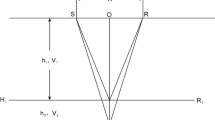Abstract
China’s continental deposition basins are characterized by complex geological structures and various reservoir lithologies. Therefore, high precision exploration methods are needed. High density spatial sampling is a new technology to increase the accuracy of seismic exploration. We briefly discuss point source and receiver technology, analyze the high density spatial sampling in situ method, introduce the symmetric sampling principles presented by Gijs J. O. Vermeer, and discuss high density spatial sampling technology from the point of view of wave field continuity. We emphasize the analysis of the high density spatial sampling characteristics, including the high density first break advantages for investigation of near surface structure, improving static correction precision, the use of dense receiver spacing at short offsets to increase the effective coverage at shallow depth, and the accuracy of reflection imaging. Coherent noise is not aliased and the noise analysis precision and suppression increases as a result. High density spatial sampling enhances wave field continuity and accuracy of various mathematical transforms, which benefits wave field separation. Finally, we point out that the difficult part of high density spatial sampling technology is the data processing. More research needs to be done on the methods of analyzing and processing huge amounts of seismic data.
Similar content being viewed by others
References
Baeten, G. J. M., Belougne, V., Combee, L., Kragh, E., Laake, A., Martin, J. E., Orban, J., Ozbek, A., and Vermeer, P.L., 2000a, Acquisition and processing of point receiver measurements in land seismic: 70th
Ann. Internat. Mtg., Soc. Expl. Geophys., Expanded Abstracts, 70, 41–44.
Baeten, G. J. M., Belougne, V., Daly, M., Jeffryes, B., and Martin, J.E., 2000b, Acquisition and processing of point source measurements in land seismic: 70th Ann. Internat. Mtg., Soc. Expl. Geophys., Expanded Abstracts, 70, 45–48.
Calvert, A., Ekstrand, E., Mclain, W., Etgen, J., Billette, F., Sen, V., Byrd, T., and Cobo, Y., 2003, Pushing the limits of resolution at Holstein: a case history from the deepwater Gulf of Mexico: 73th Ann. Internat. Mtg., Soc. Expl. Geophys., Expanded Abstracts, 73, 418–421.
Shen Chen, 2004, Petroleum geophysics engineering supervision: China Petroleum Industry Press, 197–198.
Vermeer, G. J. O., 1990, Seismic wavefield sampling: Geophysical References Series No. 4, Soc. Expl. Geophys., 27–33.
Vermeer, G. J. O., 2002, 3D seismic survey design: Geophysical References Series No. 12, Soc. Expl. Geophys., 1–12.
Wang Meisheng, and Wang Yanjuan, 2005, A case of spatial high density sampling seismic exploration: Proceedings of the 13th Symposium of Geophysical Prospecting Technique in East China, Chinese Petroleum Society, 2005.p. 48–51.
Author information
Authors and Affiliations
Additional information
Cai Xiling: Senior engineer. Graduated from the department of Geophysical Prospecting of the Petroleum University with a Bachelor degree in 1990, from the department of Earth Prospecting and Information Technology of Chengdu Technical University with a Masters degree in 2000, and is currently studying for the Doctors degree at the China Geology University. She has done research in geophysical prospecting methods and seismic data processing for many years. She is currently working in the Research Institute of BGP.
Rights and permissions
About this article
Cite this article
Cai, X., Liu, X., Deng, C. et al. Characteristics analysis on high density spatial sampling seismic data. Appl. Geophys. 3, 48–54 (2006). https://doi.org/10.1007/s11770-006-0007-2
Received:
Revised:
Issue Date:
DOI: https://doi.org/10.1007/s11770-006-0007-2




